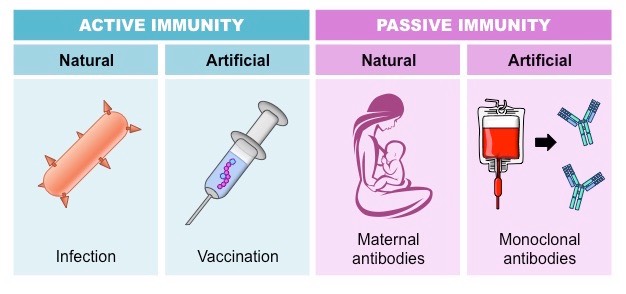Immunity And Types


Immunity And Types
The ability of the body (host) to fight against the disease causing agent is called immunity. It is of two types:-

(1) Innate Immunity :
It refers to all the defense elements with which an individual is born and always available to protect the body. It is a non-specific type of defense system.
(i) It is present from the time of birth and inherited from parents.
(ii) It consists of four types of barrier system that prevent the entry of pathogen or foreign element into the body.
Types of Barriers in Innate Immunity:-
Various types of barriers are as follows :-
(i) Physical Barriers Skin is the first line of defense :- It prevents the entry of the pathogens of the body. Mucus coating of the epithelium lining the respiratory, gastrointestinal and urogenital tracts also help in trapping microbes.
(ii) Physiological Barriers :- Acid in the stomach, saliva in the mouth, tears from the eyes, etc., prevent the growth of microbes.
(iii) Cellular Barrier :- Special types of cells in our body, which kill the disease causing agents. Example are WBCS, (leukocytes) Polymorpho Nuclear Leukocytes (PMNL-neutrophils, monocytes, macrophages, etc.)
(iv) Cytokine Barrier Cells which are virus-infected, release types of protein called interferons. Interferons the uninfected cells from further infection.
(2) Acquired Immunity
It is pathogen specific and is not present from the birth and develops during an individual's lifetime.
This type of immunity is acquired after the birth, either by contracting the disease or by vaccination.
It has the following characters :-
(i) Specificity :-It has the ability to distinguish many different foreign molecules accordingly.
(ii) Memory :- It is a unique feature, which helps in producing an intensive response when the pathogen attacks the second time.

Students / Parents Reviews [10]
I have spent a wonderful time in Abhyas academy. It has made my reasoning more apt, English more stronger and Maths an interesting subject for me. It has given me a habbit of self studying

Yatharthi Sharma
10thMy experience was very good with Abhyas academy. I am studying here from 6th class and I am satisfied by its results in my life. I improved a lot here ahead of school syllabus.

Ayan Ghosh
8thAbout Abhyas metholodology the teachers are very nice and hardworking toward students.The Centre Head Mrs Anu Sethi is also a brilliant teacher.Abhyas has taught me how to overcome problems and has always taken my doubts and suppoeted me.

Shreya Shrivastava
8thAbhyas is a complete education Institute. Here extreme care is taken by teacher with the help of regular exam. Extra classes also conducted by the institute, if the student is weak.

Om Umang
10thAbhyas Methodology is very good. It is based on according to student and each child manages accordingly to its properly. Methodology has improved the abilities of students to shine them in future.

Manish Kumar
10thIt was good as the experience because as we had come here we had been improved in a such envirnment created here.Extra is taught which is beneficial for future.

Eshan Arora
8thIt has a great methodology. Students here can get analysis to their test quickly.We can learn easily through PPTs and the testing methods are good. We know that where we have to practice

Barkha Arora
10thA marvelous experience with Abhyas. I am glad to share that my ward has achieved more than enough at the Ambala ABHYAS centre. Years have passed on and more and more he has gained. May the centre flourish and develop day by day by the grace of God.

Archit Segal
7thBeing a parent, I saw my daughter improvement in her studies by seeing a good result in all day to day compititive exam TMO, NSO, IEO etc and as well as studies. I have got a fruitful result from my daughter.

Prisha Gupta
8thMy experience with Abhyas is very good. I have learnt many things here like vedic maths and reasoning also. Teachers here first take our doubts and then there are assignments to verify our weak points.
